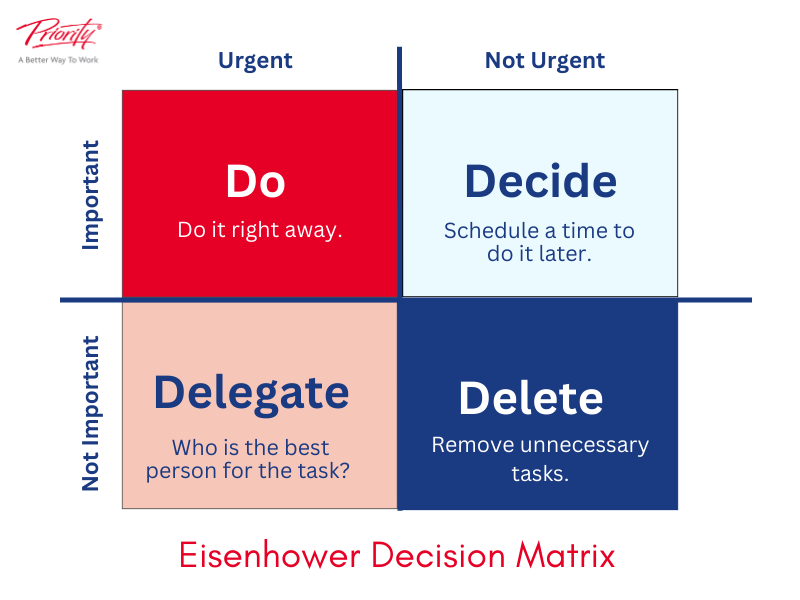Did you know that making and organising a list can help relieve stress and anxiety? That’s right, even the act of organising your to-do list can go a long way in helping you achieve your goals and minimise related stress. A great process for organising and balancing your workload is using the Eisenhower Matrix.
This method, named after U.S. President Dwight Eisenhower, helps you prioritise the tasks on your to-do list, giving you a clear path forward to reach your goals and finish projects by their deadlines.
In this article, we’ll be discussing the Eisenhower Matrix, how to prioritise your tasks, and how to use the method to improve your time and task management skills.
Key Takeaways
- The Eisenhower Matrix is a time management tool that helps users prioritise tasks on their to-do lists.
- Action items are organised into one of four quadrants, based on criteria of importance and urgency.
- The quadrants help you decide which tasks you should complete, schedule for a later date, delegate, or delete.
- Getting into the habit of regularly reviewing your tasks, goals, and deadlines will keep your workflow progressing smoothly.
What is the Eisenhower Matrix?


The Eisenhower Decision Matrix, also known as the Urgent-Important Matrix, is a productivity and time management tool used to prioritise tasks based on their urgency. Each task is sorted into one of four quadrants.
Once all your tasks are assigned to a quadrant, you can use this to prioritise and make decisions. The method was popularised by former United States President Dwight D. Eisenhower.
The 4 Quadrants of Eisenhower’s Matrix
Tasks are organised using the Eisenhower Box with the following categories:
- Urgent & Important
- Important but not Urgent
- Urgent but not Important
- Not Important or Urgent
1. Urgent & Important
Tasks in the Urgent & Important quadrant are both essential and time-sensitive, requiring immediate attention and action in order to reach the deadline.
2. Important but not Urgent
Tasks in the Important but Not Urgent quadrant are necessary but not time-sensitive, so you can schedule them to be done at a later date.
3. Urgent but not Important
Tasks in the Urgent but Not Important quadrant are typically distractions that you can delegate to someone else.
4. Not Important or Urgent
Tasks that are neither Urgent nor Important should be removed from your to-do list altogether.
Your to-do list should be prioritised in this order. Urgent & Important tasks take priority, with Important but Not Urgent items coming next. Delegate whatever you can in the Urgent but Not Important quadrant, and whatever can’t be completed by others goes at the bottom of your list. Tasks that are neither Urgent nor Important can safely be discarded.
How do tasks get prioritised using this matrix?


So, how do you apply these priority level categories to the things on your own to-do list? Let’s break it down with some examples.
Urgent & Important Quadrant
Focus on tasks that have tight deadlines and require immediate attention to prevent any problems or negative consequences.
This includes:
- Attending to important customer needs or urgent client requests that require immediate action
- Handling important legal or financial matters
- Submitting an important report or presentation before a final deadline
Important but Not Urgent Quadrant
Focus on tasks that are related to long-term goals and planning, but do not have strict or imminent deadlines.
This includes:
- Creating a long-term business strategy or marketing campaigns
- Relationship building
- Creative thinking and recognising new opportunities
- Researching new project management tools, apps, and templates
- Planning meetings with project team members
Urgent but Not Important Quadrant
These require immediate attention but are not necessarily crucial for achieving your long-term life goals, professional development, or personal growth. It’s worth noting that urgency is generally established by other people.
This includes:
- Responding to non-urgent questions, emails, or social media messages
- Doing small or optional tasks for a meeting, activities, or events
- Dealing with minor office distractions or interruptions
Tasks that are Neither in Urgent nor Important Quadrant
These are items that are not pressing and do not relate to a long-term goal.
This includes
- Attending meetings that aren’t relevant to your work
- Checking unimportant emails, email shuffling, or looking at social media
- Trivial matters and escaping to a procrastination space
- Anything that does not align with your values
How to Use the Eisenhower Decision Matrix
Now it’s time to use the Eisenhower Matrix for yourself! Once you’ve mastered this task management tool, you’ll gain all new insights into your workflow and how you spend your time and energy.
List all tasks in a digital task manager or on a sheet of paper
The first step is to list all of your tasks. You can use either an app or a digital platform like OneNote or a sheet of paper or for this step — whatever form works best for you. This will give you a clear overview of your to-do list and help you review your priorities.
Evaluate each task based on urgency and importance
Next, evaluate each task based on its urgency and importance. You can go down the list one by one and highlight each item with a different colour based on which quadrant you believe it belongs in. Carefully consider your criteria for urgency and importance; which tasks have a pressing deadline and/or are important to your long-term goals? Which items add nothing of substance to your objectives and/or have no clear deadlines?
Plot each task into one of the four quadrants of the Eisenhower Matrix
It’s time to add each task to one of the four quadrants of your priority matrix. Some people get overwhelmed by having too many tasks at once, so if this is something you struggle with, we recommend having lists of no more than 10 tasks in each quadrant.
If this leaves you with too many tasks waiting to be plotted, you can make multiple matrix; one for personal growth, one for professional development, and another for miscellaneous habits, chores, and activities.
To make sure you stay on track while you plot out tasks, try using a Pomodoro timer to manage your time.
Prioritise tasks based on their placement in the matrix
Finally, you can prioritise your tasks based on their placement in the Eisenhower Matrix. Within each quadrant, prioritise the action items based on their relative importance and urgency.
It’s also helpful to break down large tasks into smaller action items, giving you a clear view of just how much time and energy you’ll need to complete your to-do list. This will help you decide which tasks to focus on first.
Tips for Making the Eisenhower Matrix Work for You or Your Team


To fine-tune the Eisenhower Matrix to meet the unique needs of yourself and your project team members, you can customise the criteria for determining the level of urgency and importance based on your goals and priorities. Additionally, regularly review and adjust your task list and priorities to ensure that they still align with your current goals.
Integrate the Eisenhower Matrix into your daily routine
- Set aside a specific time each day to assess your tasks, progress, and priorities
- Use a digital task management tool or template to easily organise your lists
- Create a daily or weekly schedule that reflects your priorities
With time and practice, the Eisenhower Matrix can make a true difference in your day-to-day life, effectively manage your time, and increase your productivity.
Master your time management skills
Prioritising tasks and managing work time effectively is important for all professionals, healthcare providers, project managers and employees alike. Effective time management skills allow you to achieve goals, meet deadlines, reduce stress, and increase productivity.
By using the Eisenhower Matrix and other time management tips to focus on the most important and urgent tasks, you can optimise your time, reduce distractions, and achieve your objectives in a more efficient and effective manner.
Take control of your personal time
The Eisenhower Matrix is not just a tool for professional success, but also a game-changer for your personal life.
By prioritising tasks based on their urgency and importance, you can make time for the things that truly matter, whether it’s spending quality time with loved ones, pursuing a hobby, or dealing with errands.
It also helps you avoid the trap of constantly reacting to urgent but ultimately unimportant tasks, leaving you with more time and energy to focus on what brings you joy and fulfilment.
If you’re ready to implement this framework into your workflow, Priority Management is here to get you the results you need. With over 40 years of experience, our time and workload management experts know how to configure tools, programs, and methods to perfectly suit your team, your business, and your projects.
Our time management courses can be personalised to suit your needs; we’re on a mission to improve the performance of every professional and team that we work with and help them discover the perfect task management framework.
